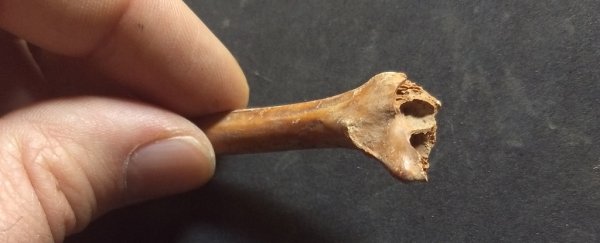Coxcatlan Cave in Mexico's Tehuacan Valley is a time capsule like no other. Its dusty floor is a history book, its pages detailing thousands of years of food and technology of the land's inhabitants.
Archaeologists from the US and Mexico have finally dug into its earliest chapter, using advanced dating techniques to determine the age of animal bones buried among the rock shelter's oldest layers.
The results were astonishing, hinting at a human presence in the area as far back as 33,000 years ago – thousands of years before ice sheets stretched to their peak, and around 20,000 years earlier than currently accepted evidence suggests.
It'll take more than a few odd radiocarbon measurements to demand a complete rethink, of course. But the results of this recent study led by Iowa State University archaeologist Andrew Somerville are bound to fuel the ongoing debate over the timeline of human migration into the heart of the Americas.
"We were surprised to find these really old dates at the bottom of the cave, and it means that we need to take a closer look at the artifacts recovered from those levels," said Somerville.
Southern Mexico's Tehuacan-Cuicatlan Valley is a UNESCO World Heritage Site for good reason. Not only is it a biodiversity hotspot, its dry climate has preserved records of human presence for thousands of years, making it a prized destination for researchers interested in the spread of our species across the New World.
The rock shelter of Coxcatlan Cave in the valley's south is a jewel in this archaeological treasure trove, with deep layers of sediment and dry conditions providing a chronology of activity reaching back at least 11,000 years.
Starting in the mid-1990s, academics began to have questions over how the cave's 'history book' should be read, with concerns over the dating of some botanical specimens pointing to its pages being out of order.
It wasn't just one or two layers either. Around three quarters of the plant materials excavated from the shelter were found dramatically out of sequence.
Though research has since come to the defense of the overall structure of the cave's timeline, understandably confidence in its reliability has remained somewhat shaken.
With the site's lowest layers yet to be fully assessed, Somerville and his team saw work needed to be done to clarify the chronology of Coxcatlan Cave.
"We weren't trying to weigh in on this debate or even find really old samples, said Somerville.
"We were just trying to situate our agricultural study with a firmer timeline."
Carrying out accelerator mass spectrometry radiocarbon dating on 14 hare, rabbit, and deer bones previously excavated from the site, the researchers came up with a catalogue of dates describing when the animals had lived.
The latest was roughly 5,000 years ago, well within a period humans were known to be in the area.
Several rabbit bones and the femur of a hare were found to date back roughly 33,000 years, a time that not only preceded all current records for the continent, but would soon be cut off from the rest of the world by climate change.
"Pushing the arrival of humans in North America back to over 30,000 years ago would mean that humans were already in North America prior to the period of the Last Glacial Maximum, when the Ice Age was at its absolute worst," said Somerville.
"Large parts of North America would have been inhospitable to human populations. The glaciers would have completely blocked any passage over land coming from Alaska and Canada, which means people probably would have had to come to the Americas by boats down the Pacific coast."
It's not the first finding to test existing models of pre-Ice Age migration onto the American continent, with a 2020 study finding 130,000 year old traces of mastodon bone scraped onto rocks from California hinting at human handiwork.
Much like the mastodon mash, these rabbit and hare bones leave plenty of room for argument. For instance, there is still the big question of whether humans were even responsible for depositing the remains in the cave in the first place.
Looking for signs of butchering and roasting would go a long way to building a case, as would finding clear signs of tool manufacture in the same layers.
It's a research project Somerville plans to undertake in the future. Such findings could help resolve the question of the bones' origins, providing an increment of evidence describing an arduous journey into southern Mexico tens of thousands of years ago.
It's the prologue to America's story we're all dying to read.
This research was published in Latin American Antiquity.
